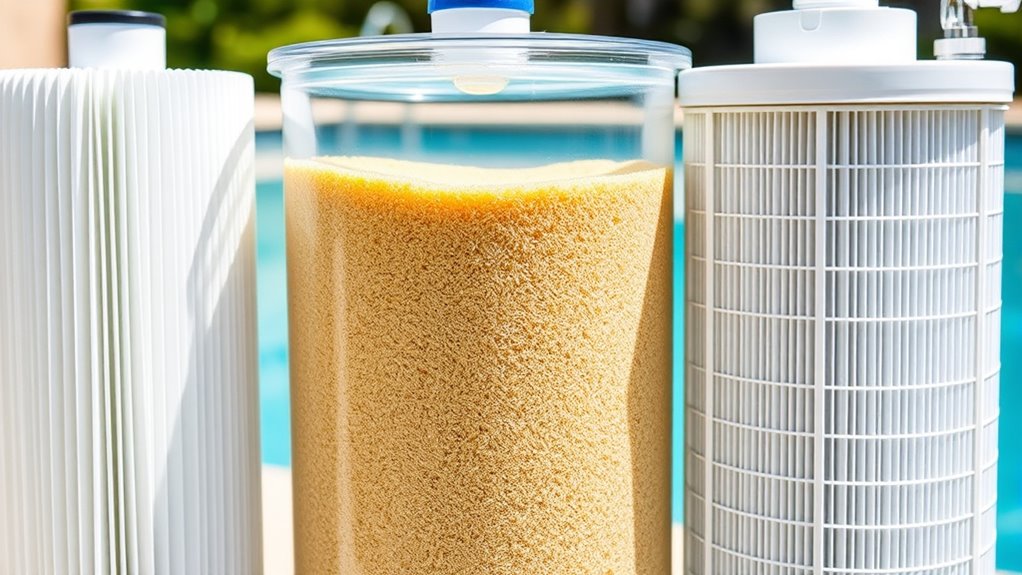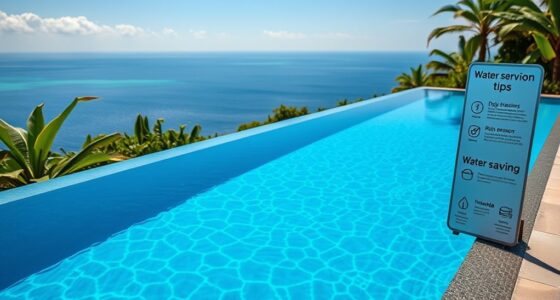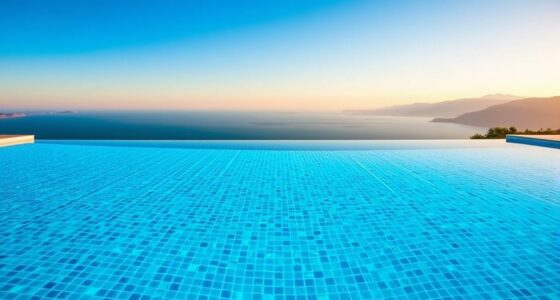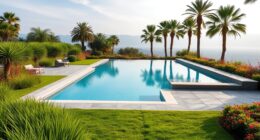Choosing between cartridge, sand, or DE filters depends on your pool’s needs. Cartridge filters are affordable and easy to clean, perfect if you want low maintenance and clear water. Sand filters handle large debris and require minimal upkeep, making them great for heavy dirt. DE filters offer the best clarity with fine filtration but cost more and need regular handling. To find the best fit for your pool, explore the details that follow.
Key Takeaways
- Cartridge filters are affordable, easy to maintain, and effective at capturing particles down to 10-20 microns.
- Sand filters are cost-effective long-term, handle large debris, and require minimal upkeep with monthly backwashing.
- DE filters offer the highest filtration power, capturing particles as small as 1-3 microns, but require more maintenance and higher initial costs.
- Choose filters based on pool size, debris load, and maintenance preferences for optimal water clarity.
- Balancing budget, ease of use, and water quality goals helps determine the best filtration option.
How Cartridge Filters Work and Their Benefits

Cartridge filters work by trapping dirt, debris, and impurities as water passes through their porous media. As water flows into the filter, tiny particles are captured on or within the filter media, preventing them from circulating back into your pool. This process results in cleaner, clearer water and reduces the load on your pool’s pump and other equipment. One of the main benefits of cartridge filters is their ease of maintenance—they can be cleaned simply by rinsing them with a hose, avoiding the need for chemical cleaning or replacement for extended periods. Additionally, cartridge filters effectively remove small particles, down to 10-20 microns, offering high-quality filtration that enhances your swimming experience. Color accuracy in filter media can influence the clarity and overall quality of the filtered water.
The Mechanics of Sand Filters and Maintenance Tips

Sand filters operate by passing water through a bed of specially graded sand, which traps dirt, debris, and other impurities. As water flows downward, particles get caught in the sand grains, providing clear water on the other side. Over time, debris accumulates, reducing filter efficiency. To maintain peak performance, you should backwash the filter regularly—usually once a month or when flow rate drops. Backwashing involves reversing the flow of water to flush out trapped debris. Additionally, inspect the sand bed annually and replace it every 3-5 years, depending on usage. Keep an eye on pressure gauges; a rise indicates dirt buildup. Proper maintenance ensures your sand filter functions efficiently, prolonging its lifespan and keeping your pool water clean and crystal clear. Regularly monitoring pressure gauges helps detect when backwashing is needed before flow rates are severely affected.
Understanding DE Filters and Their Filtration Power

Diatomaceous Earth (DE) filters are renowned for their superior filtration power, capturing particles as tiny as 1 to 3 microns that other filters might miss. This means you’ll remove more dirt, algae, bacteria, and debris, leading to clearer water. DE filters work by coating a grid or mesh with a thin layer of diatomaceous earth, which acts as a fine filter medium. When water passes through, particles get trapped in the microscopic pores of the DE layer, ensuring high-quality filtration. You can adjust the filter’s flow rate and the amount of DE to optimize performance. Because of their efficiency, DE filters often require regular backwashing and reapplication of DE powder, but they provide unmatched clarity and cleanliness for your pool.
Comparing Cost, Ease of Use, and Effectiveness

When comparing filtration options, it’s important to contemplate how cost, ease of use, and effectiveness balance out for your specific needs. Each type offers unique advantages and drawbacks:
- Cartridge filters are affordable upfront, simple to maintain, and provide good clarity, making them ideal for small pools or quick maintenance.
- Sand filters are cost-effective over time, require minimal upkeep, and efficiently handle large debris, suitable for medium-sized pools.
- Diatomaceous Earth (DE) filters are the most effective at capturing tiny particles, but they cost more initially and need more careful handling.
- Considering retail hours can help you plan your purchase or maintenance visits more conveniently.
Assess your budget, maintenance willingness, and water quality goals to choose the best option for your pool.
Choosing the Right Filter Based on Your Pool Needs

To choose the right filter for your pool, start by evaluating your specific needs and priorities. Consider how often you swim and the size of your pool, since larger pools require more efficient filtration. If you want low maintenance and quick cleaning, a cartridge filter might suit you best. For heavy dirt and debris, a sand filter offers durability and ease of use. If you prioritize crystal-clear water and fine filtration, a DE filter provides superior clarity but requires more upkeep. Also, think about your budget, local climate, and how much time you’re willing to dedicate to maintenance. Matching your pool’s size, usage frequency, and your maintenance preferences will help you select the most suitable filtration system. Additionally, understanding the cost‑of‑ownership involved with each type can help you make a more informed decision.
Frequently Asked Questions
Which Filter Type Is Best for Large Debris Removal?
You should choose a sand filter for large debris removal. Sand filters excel at trapping bigger particles like leaves, dirt, and algae, thanks to their coarse filtration media. They are easy to maintain and cost-effective for large pools. Regular backwashing keeps the filter functioning efficiently. While cartridge and DE filters offer finer filtration, sand filters are your best bet for handling substantial debris effectively.
How Often Should Filter Media Be Replaced or Cleaned?
Think of your filter media as a garden that needs tending. You should clean or replace it based on usage and water quality, typically every 4-6 weeks. If you notice reduced flow or cloudy water, it’s time for a change. Regular maintenance keeps your pool sparkling and prevents debris buildup, so stay vigilant and give your filter some TLC to guarantee peak performance all season long.
Can Different Filter Types Be Used Together?
Yes, you can use different filter types together, but it’s important to make sure to do so carefully. Combining filters like cartridge, sand, and DE can improve water clarity and filtration efficiency. However, you should verify compatibility and proper flow rates to prevent damage and maintain filter longevity. Always follow manufacturer guidelines and consider consulting a pool professional to design an effective multi-stage filtration system tailored to your pool’s needs.
What Are the Environmental Impacts of Each Filter Type?
Imagine you’re in a sci-fi movie — now, consider each filter’s environmental impact. Cartridge filters produce waste that often ends up in landfills, while sand filters are more eco-friendly with minimal waste. DE filters require handling hazardous materials, posing disposal challenges. You should weigh these factors to minimize your ecological footprint, choosing the most sustainable option. Always consider the environmental costs before your next pool upgrade to keep our planet as pristine as your pool.
Are There Specific Filters Recommended for Saltwater Pools?
For saltwater pools, DE filters are often recommended because they provide superior filtration, capturing tiny particles and improving water clarity. They help maintain a clean, healthy environment by removing contaminants more effectively. Cartridge filters are also suitable, offering easy maintenance and good filtration for smaller saltwater pools. Sand filters are less common but can work for larger pools, though they might not filter as finely as DE or cartridge options.
Conclusion
Choosing the right pool filter is like finding the perfect pair of shoes—it depends on your needs and preferences. Cartridge filters are like reliable sneakers, offering ease and convenience. Sand filters are the sturdy boots, great for regular maintenance. DE filters, like high-performance running shoes, deliver exceptional cleanliness but require more care. Assess your pool size, budget, and maintenance comfort to pick the filter that keeps your pool crystal clear and inviting.









